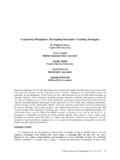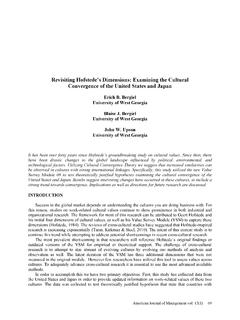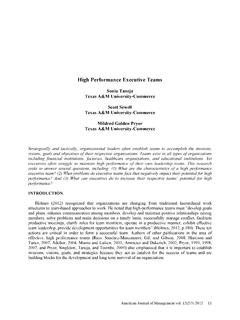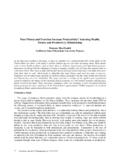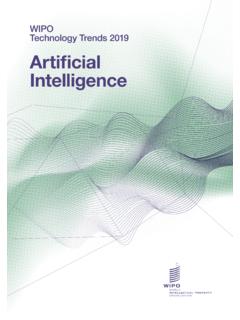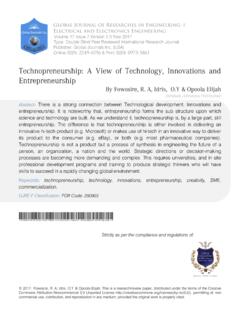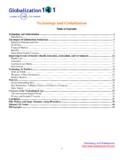Transcription of Technology’s Effect on Hotels and Restaurants: Building a ...
1 technology 's Effect on Hotels and Restaurants: Building a Strategic Competitive Advantage Dean A. Koutroumanis University of Tampa The changing face of technology has played an integral role in the development of the hotel and restaurant industry. The manuscript investigated the impact that technology has had on the hotel and restaurant industry. A detailed review of the literature regarding the growth of technology in the industry was linked to the development of strategic direction. The manuscript also looked at the strategic analysis methodology for evaluating and taking advantage of current and future technological innovations for the hospitality industry. Identification and implementation of these technologies can help in Building a sustainable competitive advantage for Hotels and restaurants. INTRODUCTION. Current economic conditions have had a dramatic, negative financial impact on the hospitality industry (Brandau, 2009). Consumer behavior patterns have been changed for multiple reasons, including high levels of unemployment, a deep recession, and overall fear of what the future holds.
2 Hoteliers and restaurateurs will need to look at various strategic vehicles to build and regain customers. The face of innovation in technology is continually changing. The hotel and restaurant industry needs to take a proactive stance in implementing technological advances, while continually striving to build levels of service quality and guest loyalty (Magnini, Honeycutt, & Hodge, 2003). A 2004 study conducted by the National Restaurant Association stated that 70% of a restaurants business base comes from repeat customers. The same survey asked restaurateurs if it was getting more difficult to maintain customer loyalty. Fifty-two percent of the respondents said yes (Sanson, 2004). Tapping into customers needs through the use of information can be instrumental in Building loyalty and gaining competitive advantage (Piccoli, 2008). Hotels and restaurants are continually competing for employees, locations, and more recently information about customers. As more people are using the Internet there is a high amount of information that is being captured on web server logs (Garver, 2002).
3 Proper extraction of this information coupled with high levels of service is what will help the hotel and restaurant industry build competitive advantage in a troubled economy. An organizations ability to take advantage of external environmental factors will help the firm sustain and grow in economically challenging times (Oparanma, Hamilton & Accra-Jaja, 2009). Piccoli, Spalding, and Ives (2001) stated that organizations need to structure the way they think around how customers think and act. By accomplishing a customer-centered focus, companies will be able to highlight their strengths and highlight opportunities for improvement. Information regarding customers will continue to have a big impact on the future of the industry. This information base can be seen through the explosion of personal and business social network sites such as LinkedIn, Facebook, and 72 Journal of Applied Business and Economics vol. 12(1) 2011. Twitter. Identifying patterns of current and potential customers and servicing their needs is one way that organizations are attempting to use information as a leverage tool against competitors (Magnini, et al.)
4 , 2003; Piccoli, 2008). The following manuscript analyzed the strategic analysis methodology for evaluating and taking advantage of future technological innovations for the industry. Proactive identification and implementation of these technologies can help in Building a sustainable competitive advantage (Piccoli, 2008). The manuscript additionally reviewed the existing literature regarding the role technology has played in the hotel and restaurant industry and how strategic innovation has spurred best practices for the industry. STRATEGIC ANALYSIS AND INDUSTRY IMPLICATIONS. Strategic analysis examines both environmental and firm environments, which are integral components of strategy development. Understanding the impact that environmental factors have on organizations is of paramount importance in Building successful firms (Oparanma, et al., 2009). In a worldwide study of firms spanning a variety of industries, 81% of companies reported conducting strategic analysis (Harrison, 2003).
5 Additionally, studies have shown that firms that engage in strategic planning tend to have higher levels of performance (Miller & Cardinal, 1994). The strategic management process is a dynamic process and one of continual change and improvement. The dynamic nature of the process stems from the ever-changing environments in which companies operate. The mere fact that change remains a constant in business environments should be a driver for organizations to be proactive and embrace the strategic management process. The core of the strategic management process breaks down into three functional components: strategy formulation, strategy implementation, and strategy evaluation (David, 2009). Although the core functions appear to be simple in nature, the systematic and in depth analysis of the functions is the driving force behind the process. FIGURE 1. THE STRATEGIC MANAGEMENT PROCESS (adapted from David, 2009). Strategy Strategy Strategy Formulation Implementation Control *Review vision, mission, *Allocation of financial *Identify benchmark and objectives resources feedback mechanisms for strategy evaluation *Conduct external and *Allocation of human internal analysis resources Feedback Feedback The strategy formulation component is the driving force of the analysis.
6 An in depth look at firm direction begins at this point. The focus in this stage is to assess the current vision, mission and objectives of the organization in addition to examining both the external and internal environments. From an external perspective, organizations need to look at two distinct environments: the broad environment and the task or firm environment (Harrison & St. John, 2008; Harrison, 2003). The broad environment looks at factors, including societal trends , technological advances political and legal trends , economic factors and other major industry innovations. The task or firm environment looks at factors such as customers, competition, government agencies, suppliers, and financial intermediaries. Finally, the internal environment focuses on factors within the organization such as management, financial, and human Journal of Applied Business and Economics vol. 12(1) 2011 73. resources and general organizational competencies (David, 2009; Harrison & St.)
7 John, 2008; Harrison, 2003). After careful evaluation and measurement of these environments, executives develop strategies to pursue that will enhance the longevity of their respective organizations. The implementation stage looks at engaging both financial and human resources in the pursuit of the strategies. The final stage of the process reviews strategy execution on a continual basis and allows for feedback and adjustment (David, 2009; Harrison & St. John, 2008; Yang & Fu, 2007). The Broad Environment Opportunities are discovered when organizations begin to analyze the broad environment. Hoteliers and restaurateurs need to be cognizant of these factors and how they can drive change in the industry. Societal trends and technological trends should be critical points of interest for industry executives. From a societal perspective, organizations need to look at influences such as current hot topics, emerging attitudes, demographic shifts and new fads (Oparanma, et al.
8 , 2009; Harrison, 2003). An example of societal trends that are impacting the hospitality industry would include the explosion of social networking. The trend has spanned across several demographic barriers ranging from Baby Boomers to the Millennials. There has additionally been an enormous affect on the hotel and restaurant industry. Bloggers have launched sites commenting about experiences that they have had and have made recommendations regarding the hotel or restaurant. Savvy industry executives understand the impact of these societal trends and focus efforts on establishing methodologies that can incorporate appropriate strategies to take advantage of these trends (Luebke, 2010). Table 1 depicts some of the more popular social networking sites to date. TABLE 1. SOCIAL MEDIA SITES (adapted from Luebke, 2010). Social networking site connecting family, friends and acquaintances. Social networking site primarily used by business professionals One of the original social networking sites.
9 Primarily used for friend to friend communications Twitter ( ) One of the newest iterations of social networking. Helps the tweeters keep track of what everyone is doing in real time. Blogs were launched in 1999. ( ) and create a forum for individuals to speak and report anything on their minds One of the most popular social media sites, where individuals upload and share video clips Technological advances focus on the innovation of products, procedures, or services and how these developments can affect the hospitality industry (Yang & Fu, 2007; Harrison, 2003). For example, online reservations have grown exponentially over the years (Jin-Zhao & Jing, 2009). The ability for industry executives to recognize the implications of this technological advance and develop strategies to take advantage of it is a critical component of strategy development. One of the premier online reservation 74 Journal of Applied Business and Economics vol. 12(1) 2011. portals, , boasted that in 2006 dining seats filled in restaurants through the use of their online reservation system exceeded one million (Ross, 2006).
10 This was a 65% increase from the previous year. Industry leaders, not acknowledging this technological advance and implementing it in some capacity would find their companies lagging in providing the appropriate customer service that their clientele would demand. Delay in the implementation of technological advances of this magnitude detracts from developing sustainability and competitive advantage (Jin-Zhao & Jing, 2009; Piccoli, 2008;. Yang & Fu, 2007). Figure 2 considers the full gamut of environmental factors that need to be addressed in the external analysis component of the strategic formulation process. FIGURE 2. ENVIRONMENTAL FORCES IMPACTING ORGANIZATIONS. (adapted from Harris & St. John, 2008). ENVIRONMENTAL FACTORS. THE BROAD ENVIRONMENT. technological socio-cultural forces forces THE FIRM / TASK ENVIRONMENT. competitors financial intermediaries suppliers local communities customers unions local government economic political/legal forces forces technology 'S IMPACT IN THE HOTEL INDUSTRY.

